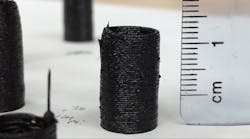Additive manufacturing (AM) and three-dimensional (3D) metal printing are making enormous impacts on how precision metal parts are being constructed. In contrast to traditional subtractive manufacturing methods, where material is removed from a supply to leave behind a part in the desired shape and size, AM forms a desired part by adding layer upon layer of material to form the required dimensions with great precision.
One of the questions raised by this technology has been the integrity of the bonds between layers. The U.S. Air Force Research Laboratory (USAF) at Wright-Patterson Air Force Base, in conjunction with researchers from the AFRL Materials and Manufacturing Directorate, recently examined the layers of a 3D printing process with the aid of a high-energy x-ray system at the National Synchrotron Light Source II at Brookhaven National Laboratory (see photo).
Dr. Hilmar Koerner of the Polymer Matrix Composite Materials and Processing team at AFRL explained that this was a rare opportunity to gather materials data: “We were awarded beam time at the X-ray Photon Correlation Spectroscopy (XPCS) beamline, which allows us to simultaneously look at the dynamics and structure of the materials during processing with millisecond time resolution.” The research was used to reveal in real time how nanofillers added to layers of materials deposited with 3D metal laser printers could strengthen the final structure.
Koerner pointed out that when the composite-material-based ink is deposited from the 3D laser printing nozzle, it is transformed from a shear-thinned flowable liquid into a thicker gel in just a few seconds. The nanofiller particles within the liquid and then the gel are random in orientation, forming a network that gives the composite material ink its self-supporting properties and its capabilities to maintain a shape.
By using the XPCS beamline to take a closer look at this reaction, the researchers were able to examine this fast-setting process in great detail, gaining insight into how to optimize the composition of the printing ink—as well as the 3D metal printing process—for improved results.
“We were excited to find out that we had been granted beam time at this unique beamline,” Koerner added. “We conducted our experiments and gathered data that will allow us to better characterize these materials and shed some light into the 3D printing process of Air-Force-relevant thermosetting resins and their post-processing.” Application of these new data is expected to greatly improve the AFRL’s 3D printing efforts and the performance of the parts fabricated with such AM printing processes.

